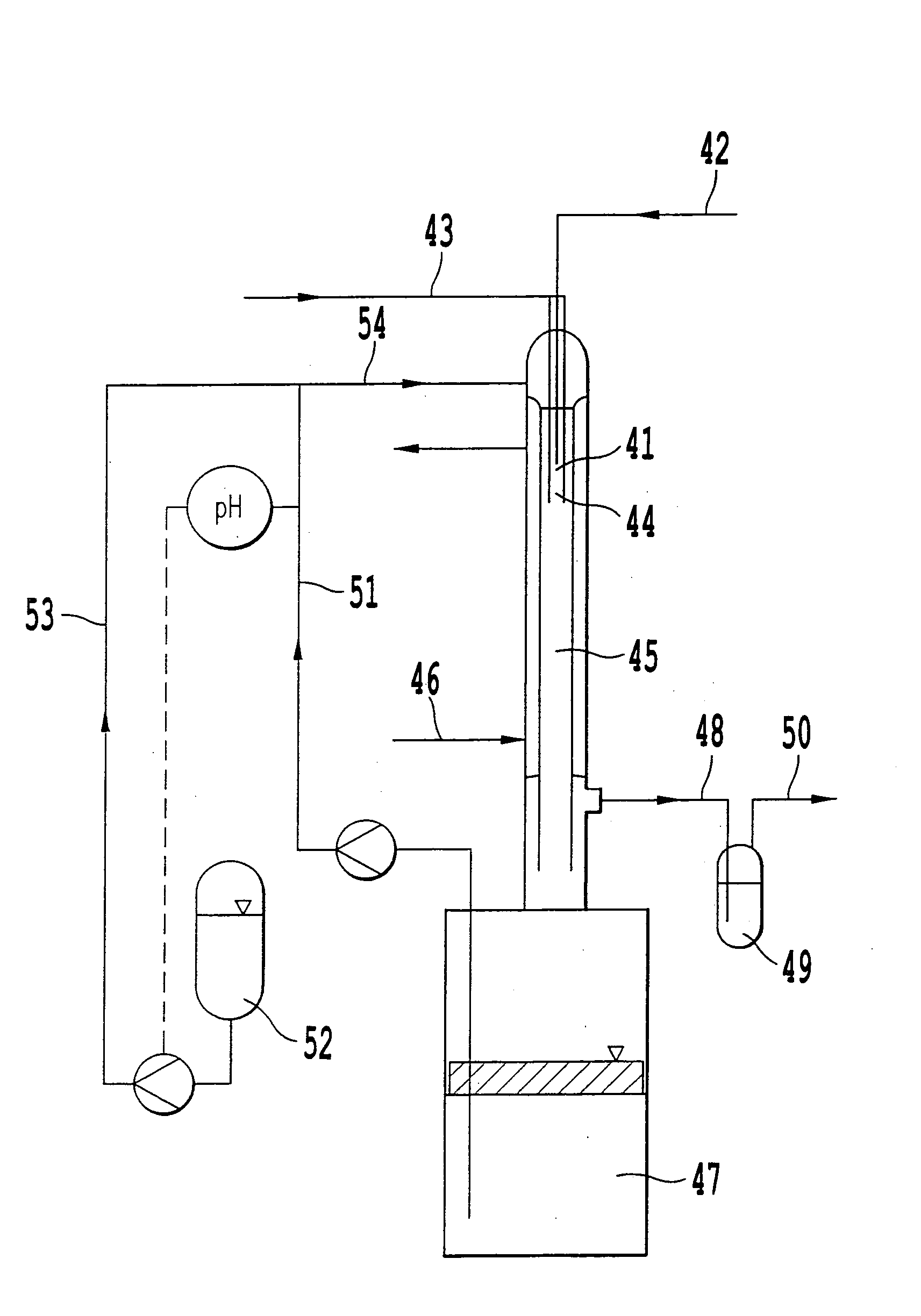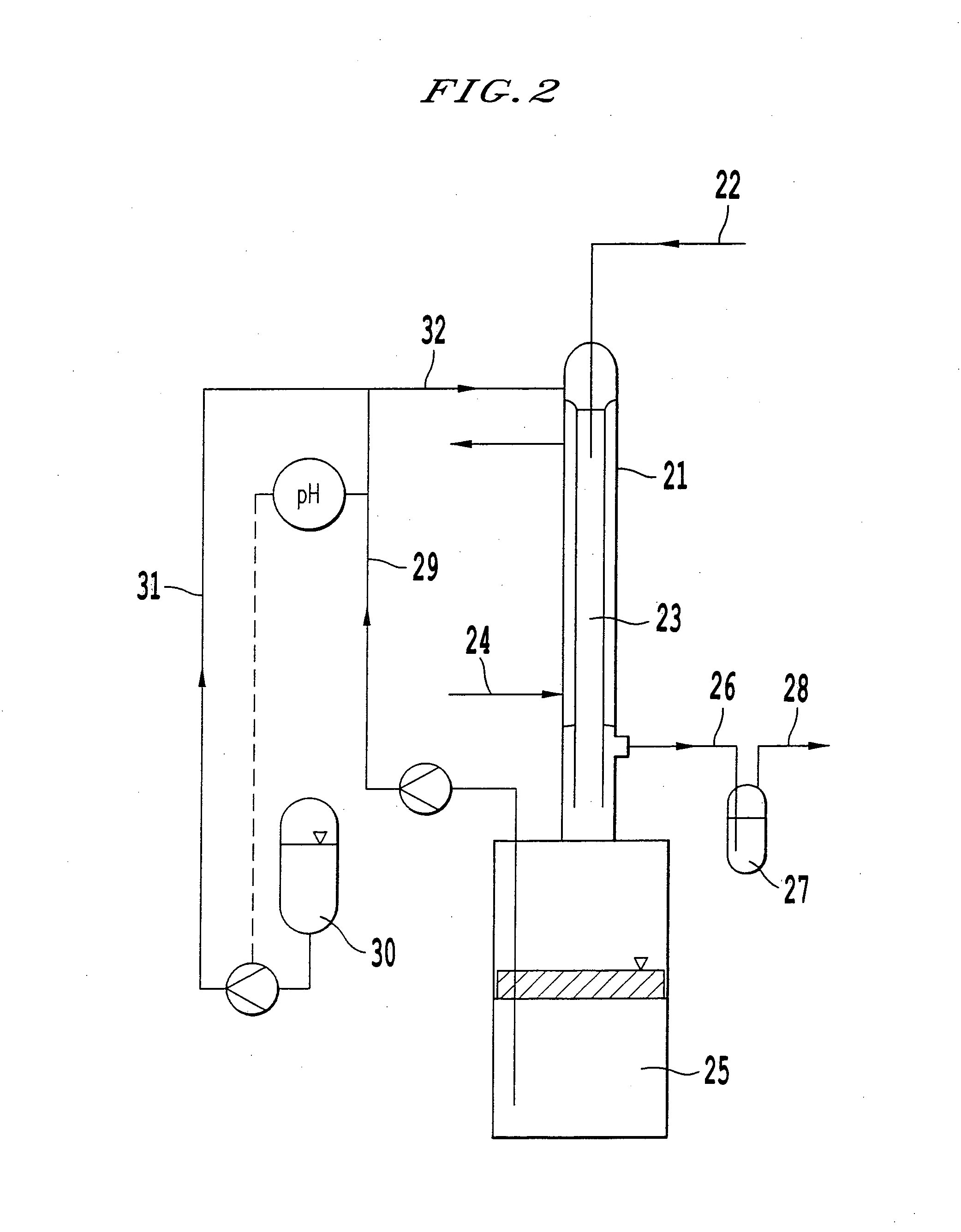Process for the separation of chlorosilanes from gas streams
a technology of chlorosilane and gas stream, which is applied in the direction of separation process, silicon compound, lighting and heating apparatus, etc., can solve the problems of converting waste gas into waste water, large amount of chlorosilane, and considerable vapor pressure, and achieve the effect of effectively removing chlorosilane from gas stream
- Summary
- Abstract
- Description
- Claims
- Application Information
AI Technical Summary
Benefits of technology
Problems solved by technology
Method used
Image
Examples
first embodiment
[0016]In the first embodiment of the process of the present invention, the gas stream containing chlorosilanes is first treated at a temperature of at least 125° C., preferably 130 to 250° C., with independently supplied steam. The first embodiment differs in this respect from the second embodiment, described below. Preferably, the gas stream is mixed with superheated steam, such that the mixed gas / steam stream has a temperature of at least 125° C., preferably 130 to 250° C. For a given steam temperature, the amount of steam employed may be lower if the gas stream is preheated indirectly to a temperature of up to 200° C., e.g. to 40 to 200° C.
[0017]The steam serves as both a source of heat, as well as a reactant in the hydrolysis of the chlorosilanes. In the course of the hydrolysis reaction, hydrogen chloride is produced. Si—H bonds, however, remain unaffected. As discussed above, the chlorosilanes produced by hydrolysis with steam in the first stage of the process afford a primary...
second embodiment
[0028]In a second embodiment of the process of the present invention, another aqueous liquid is employed as the liquid, aqueous phase for the treatment of the gas stream instead of the condensate derived from steam. In this process, the optionally preheated gas stream generally has a temperature of up to 200° C., for example from 5 to 200° C., preferably from 30 to 150° C., and the temperature of the other aqueous liquid is generally 10 to 90° C., in particular 20 to 50° C. Water vapor is present in the gas phase above the other aqueous liquid at a partial pressure of 12 to 700 mbar, depending on the temperature of this other aqueous liquid, and serves as steam for the first stage of the treatment of the gas stream, according to the present invention. This first stage treatment is followed by the second stage of the treatment, in which the gas stream is treated with the other aqueous liquid.
[0029]The other aqueous liquid can be water, e.g. tap water, steam condensate or deionized wa...
third embodiment
[0033]The third embodiment of the process of the present invention is a combination of the two first embodiments. Thus, steam is employed for the treatment of the gas stream in the gas phase in the first stage of the treatment, and additionally another aqueous liquid not exclusively produced by condensation of the steam is employed for the second stage of treatment of the gas stream. The gas stream is thus treated with both this “other aqueous liquid” and with the condensed steam. The “other aqueous liquid” may be water or a basic, aqueous liquid. Alternatively, the heterogeneous condensate or its aqueous phase may be used by recirculating a part of the liquid which collects at the bottom of the cooling container. It is possible, for example, to pass the “other aqueous liquid” or the aqueous phase of the heterogeneous condensate through a ring line in the uppermost part of the cooling container 5 of FIG. 1 on its cylindrical inner wall. This promotes the separation of the heterogene...
PUM
| Property | Measurement | Unit |
|---|---|---|
| length | aaaaa | aaaaa |
| length | aaaaa | aaaaa |
| temperature | aaaaa | aaaaa |
Abstract
Description
Claims
Application Information
 Login to View More
Login to View More - R&D
- Intellectual Property
- Life Sciences
- Materials
- Tech Scout
- Unparalleled Data Quality
- Higher Quality Content
- 60% Fewer Hallucinations
Browse by: Latest US Patents, China's latest patents, Technical Efficacy Thesaurus, Application Domain, Technology Topic, Popular Technical Reports.
© 2025 PatSnap. All rights reserved.Legal|Privacy policy|Modern Slavery Act Transparency Statement|Sitemap|About US| Contact US: help@patsnap.com



